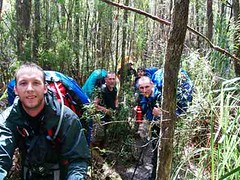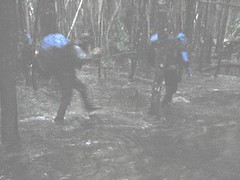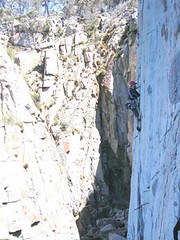It was the most twisted of nightmares.
It began with my shouted name. Ripped into wakefulness, I felt the tent floor moving, like some sort of beast, beneath my sleeping bag.
I couldn’t focus my eyes and a rushing sound filled my ears. A light came on and a stern face appeared.
I tried to put on my eyeglasses but they crumbled, broken in my hand. I found my contact lenses and they went on as if guided by an unseen hand.
My sight restored, I poked my head outside and began yelling. In seconds, monsters with glowing mono-eyes were grunting and bellowing, stuffing huge sacks as a black river rose around their legs.
The reality was simpler.
In the stygian darkness of a Tasmanian pre-dawn, on January 28, 2007, the South Cracroft River had flash-flooded and our campsite was fast disappearing under water.
What had begun as well-planned expedition to climb Federation Peak in South-West Tasmania was ending in a fury of tannin-coloured waters, as one and then three of our four tents were flooded.
Once carefully packed rucksacks now became mere containers for the desperate cramming of sodden gear, as the river continued to rise around our legs.
When Brian and Luke Richardson’s tent literally ended up under water, it became apparent that our trip had ended less than 24 hours after it had begun.
Six months of training walks, self-rescue sessions and long traditional climbing routes in the Blue Mountains had been included as part of the mental and physical preparation for our ascent of Australia’s highest cliff.
Six-hundred metres and 20 pitches of climbing up to Ewbank grade 18 was to be our reward for two days of carrying 30kg-plus packs.
We had chosen to access the remote South-West Tasmanian peak via the shortest route possible, the notorious Farmhouse Creek Track.

That was the plan. Unfortunately the Tasmanian summer had other plans.
When we disembarked from the rented people-carrier at the trackhead, it was raining.
As we posed for a group photograph the sun came out briefly, before once again being swallowed by the clouds. Apart from few feeble rays over the next few hours, that was the last of the sun.
On that first day we had planned to cover 18km and sleep at Cutting Camp before pushing on to Bechervaise Plateau, via the short and nasty Moss Ridge. From Bechervaise the climbing teams – Gus Davidson and I, Rick Fielding and John Shaw – would push onto Blade Ridge and in a two-day push link it with the North-West Face Route.
As it transpired, by near sundown on the first day we’d covered just 9km and found ourselves on the banks of the rising South Cracroft River.
Our progress had been slowed by a combination of our massive packs and the exhausting effort of having to negotiate dozens of massive, slippery, fallen trees that choke the Farmhouse Creek track.
With little choice, we bunked down for the night, feeling positive that the next day would be better. While the river was rising, checks later in the night indicated that it had slowed.
It was not until 5.30am – about two hours after the last level check – that Gus’s shout of my name, and the feeling of our tent floating, revealed that the river had broken its banks.
For the next two hours the eight of us worked in a frenzy to rescue our gear from the rising waters. When the madness ended it was 7.30am. At least two of the team had saturated sleeping bags, while three of the tents had been soaked inside and out.
 I had no intention of being forced into a position where we would have to activate the EPIRBs that NSW electronics company GME had loaned us for the trip.
I had no intention of being forced into a position where we would have to activate the EPIRBs that NSW electronics company GME had loaned us for the trip.With no sign of the weather abating and the knowledge that the track in front of us followed the now raging floodplain for at least another 9km, the decision was regretfully made to abandon the trip.
For the first hour we waded through waist-high waters: the muddy buttongrass plains had become a river. With the track gone, the Garmin GPS units – again courtesy of GME – proved invaluable, as we followed the electronic breadcrumb trail back through the now flooded maze of thick scrub.
Nine hours after we had fled the South Cracroft River we were back at the car park where we had started. With no phone coverage and no scheduled pick-up for almost a week, we set up our sodden tents in the equally sodden car park, prepared for a long wait.
Then luck found us: Some rafters happened upon us and agreed to take one of our members – Simon Kearney – back to Hobart. The following morning Simon arrived with the rented bus and my worried parents in tow. In a few hours we were back in Hobart.
Determined to get some climbing in on this, so far, climbing-free trip, I proposed that we head for the granite cliffs of Coles Bay on Tasmania’s East Coast. Within a few hours six of us had downgraded our transport to a heavily laden Tarago and we were bound for the coast.
Luke and Brian elected to stay behind and make a tourist flight around Federation Peak. As it turned out, the weather in the South-West stayed rotten for three days. Scenic flights were grounded by 100km winds around the Federation Peak area, forcing Brian and Luke to return home to NSW.
Meanwhile, John, Rick, Gus, Simon, Jim Dickins and myself – along with John’s wife Marian and Marian’s dad Wizz – enjoyed four near-perfect East Coast days.
I hadn’t climbed in the area since the early ’90s but armed with the brand new Climb Tasmania guide and the older Craglets guide we picked out some classic easy lines.
We revelled in the warm, bombproof and high-friction granite trad routes. Among my highlights were beautiful crack climbs such as Cordon Bleu (15), on Lassie’s Wall and Slaughterhouse Five (16) on Whitewater Wall. Equally pleasant was the RP-protected corner Ice Nine (16) and several low-grade rambles up the 50m-high Whitewater Wall.

Perched high above the surging Southern Ocean, we used yet another GME product - UHF two-way radios - to communicate on the multi-pitch routes on the pleasant Whitewater Wall. For Team Pom - Rick and John - the opportunity to use the well-practised routines they had planned to use on Federation was not to be missed.
For Team Slackarse - Gus and I - it was a case of high quality cragging.
Whatever style was used, the climbing teams found that the East Coast days went a long way toward erasing the memory of our abortive Federation trip. It's hard to beat days on warm rock, bookended by bakery breakfasts and pub climbing post-mortems.
This erasure process continues, such that, among some members, there sounds to be the low rumblings of once more organising a trip to Federation Peak.
If and when they do come knocking, I hope that I’m not home.